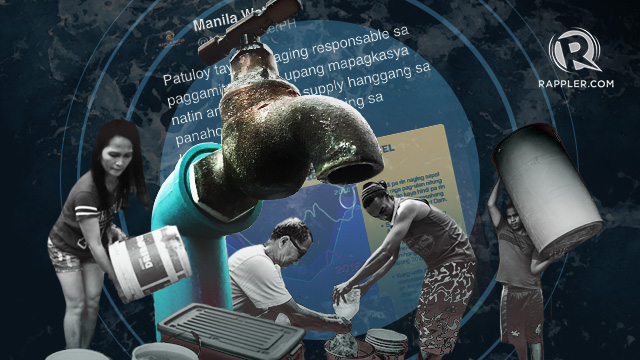

It’s like jumping off a frying pan and into the fire.
Metro Manila’s water woes are back. Angat Dam’s water level has dropped again (Figure 1), prompting new rounds of water service interruptions last week.
Patuloy tayong maging responsable sa paggamit ng tubig upang mapagkasya natin ang limitadong supply hanggang sa panahon ng tag-init at maging sa kabuuan ng taong 2020. pic.twitter.com/aAgVx9z1MJ
— Manila Water (@ManilaWaterPH) October 23, 2019
Figure 1.
In response, President Rodrigo Duterte said he’s mulling a takeover of Metro Manila’s two water concessionaires, Manila Water and Maynilad.
“I’m taking stock of my options,” said Duterte. “Expropriation or outright police power. You just go to court and file a case if you want. I will start to find a way to connect the water to the people.”
Doubtless a water crisis is upon us. But Duterte is evidently clueless about the roots of the crisis and what to do about it.
First, Duterte is clearly misremembering – or totally ignorant of – the older crisis we had back when water distribution was in the hands of government.
Second, pointing fingers at the concessionaires distracts us from the government’s many failures that are largely to blame for today’s crisis.
'Mura kaya lang wala'
Fewer people now remember that water distribution in Metro Manila used to be operated by government itself.
Prior to privatization in 1997, water was distributed, not by private corporations, but by a government agency called the Metropolitan Waterworks and Sewerage System (MWSS).
In a nutshell, the MWSS did a crappy job.
Less than 70% of Metro Manila had access to water. For those lucky enough to have any connection at all, water was intermittent and available for only about 17 hours a day.
Service interruptions were commonplace, and so much more households had to endure long queues (“pila balde”). Water pressure was also pathetically weak, and this made the water often murky and not potable.
Lots of water also got wasted due to widespread leaks, illegal connections, tampered meters, and the unlawful use of fire hydrants.
More often than not, MWSS employees themselves made a racket out of these illegal connections.
As mentioned to me by National Scientist Raul V. Fabella on the Usapang Econ Podcast, the MWSS also "doubled as an employment agency" and was “heavily overmanned.” Officials and employees had no incentive to improve the quality of water distribution, for they got their salaries, bonuses, and other perks irrespective of their performance.
Sure, water rates (or “tariffs”) back then were quite low. But that was because they were heavily subsidized by the government. This meant that taxpayers from outside of Metro Manila – like in Cebu or Zamboanga – had to pay for MWSS’ lousy operations even if they didn’t benefit from it at all.
In sum, water back then was – in Dr Fabella’s words – “mura kaya lang wala (cheap but wanting).”
Privatization
In the 1990s, Filipinos finally had enough. Government was clearly not up to the task of distributing water.
So in 1995, Congress passed the National Water Crisis Act which, among other things, privatized the MWSS.
In place of the MWSS, two concessionaires provided water across Metro Manila: Manila Water in the East Zone, Maynilad in the West Zone.
Today the MWSS still owns the pipes, plants, and dams. But when it comes to operations, the MWSS merely oversees and regulates the concessionaires.
Water privatization proved to be a boon: it reversed many – though not all – problems that used to plague water distribution.
In 2002, merely 5 years since privatization, there was an 18% increase in water coverage, as well as a 24% rise in the number of hours that water was available. Water rates also appreciably declined, at least immediately after privatization.
Quality also significantly improved over that period, to the point that the incidence of water-borne diarrhea nearly halved from 1998 to 2002, as shown in a recent study.
Water management drastically improved, too. Staffing became significantly leaner, operations much more responsive, and water wastage a lot less prevalent – although this last thing took a longer time to happen (Figure 2).
Figure 2.
Needless to say, water privatization – essentially a public-private partnership – was no cure-all.
Water rates have since escalated, and recently Manila Water even threatened it would impose a whopping 780% rate hike because they’re being penalized by the Supreme Court for failing to comply with the Clean Water Act. Why on earth should consumers bear that penalty?
Nonetheless, things could be way worse. If you think water distribution is terrible now, wait till it reverts back to government control – as Duterte would have it.
Government failure
Our present water woes are the product not so much of the concessionaires’ failures – or privatization’s drawbacks – but of the MWSS’ weakness as a regulator.
As I explained before, recurring shortages today reflect the fact that water demand in Metro Manila is outstripping supply. (READ: The economics of Metro Manila’s burgeoning water crisis)
On the face of it, the solution seems simple enough: find new water sources. But whose responsibility is this?
Bafflingly, this is not spelled out in the concession agreements. But the 1996 Privatization Strategy Report of the MWSS stated: “The concessionaires…will be responsible for the supply of their respective future bulk requirements.”
Even so, the concessionaires cannot develop new dams or reservoirs without the go signal of the MWSS.
Manila Water recently got lucky since the MWSS finally greenlit their proposed Wawa Bulk Water Supply project, which is expected to add 500 million liters per day (MLD) to their supply.
But many other projects were actually in the pipeline, and MWSS did little to act on them quickly enough to avert today’s water shortages.
MWSS Chief Regulator Patrick Ty admitted on TV, “Yes, it’s our fault. It’s everyone’s fault because we’ve been delaying all these projects.”
By “everyone,” Ty meant to share the blame on indigenous peoples (IP) groups and environmental NGOs “blocking all these alternative water sources.”
I don’t see how downplaying these groups’ concerns will do us any good.
The controversial Kaliwa Dam, for example, is expected to inundate communities in General Nakar and Infanta, Quezon. While it promises to quench Metro Manila’s water needs in the coming years, Kaliwa Dam will definitely displace the Dumagat-Remontado people and permanently disrupt the area’s ecosystem.
Amid mounting opposition against the Kaliwa Dam – funded and to be constructed by the Chinese – Duterte said he will use his “extraordinary powers” to see the project through.
There should be no real tradeoff between looking for new water sources and looking after the plight of IP groups and the environment.
If there appears to be such a tradeoff, it again reflects the government’s lack of planning and strategy, above anything else.
Scary prospect
It’s bad enough that Metro Manila’s water shortages are only expected to get worse as we await the completion of Kaliwa Dam around 2022.
But Duterte’s suggestion of bringing government back in the business of water distribution – no matter how far-fetched – is a surefire way for shit to hit the fan.
It’s a scary prospect, by far the scariest thing I heard this Halloween. – Rappler.com
The author is a PhD candidate at the UP School of Economics. His views are independent of the views of his affiliations. Follow JC on Twitter (@jcpunongbayan) and Usapang Econ (usapangecon.com).